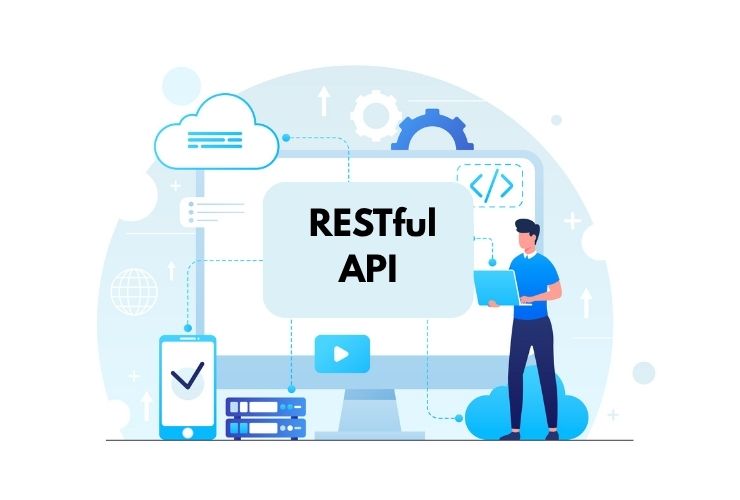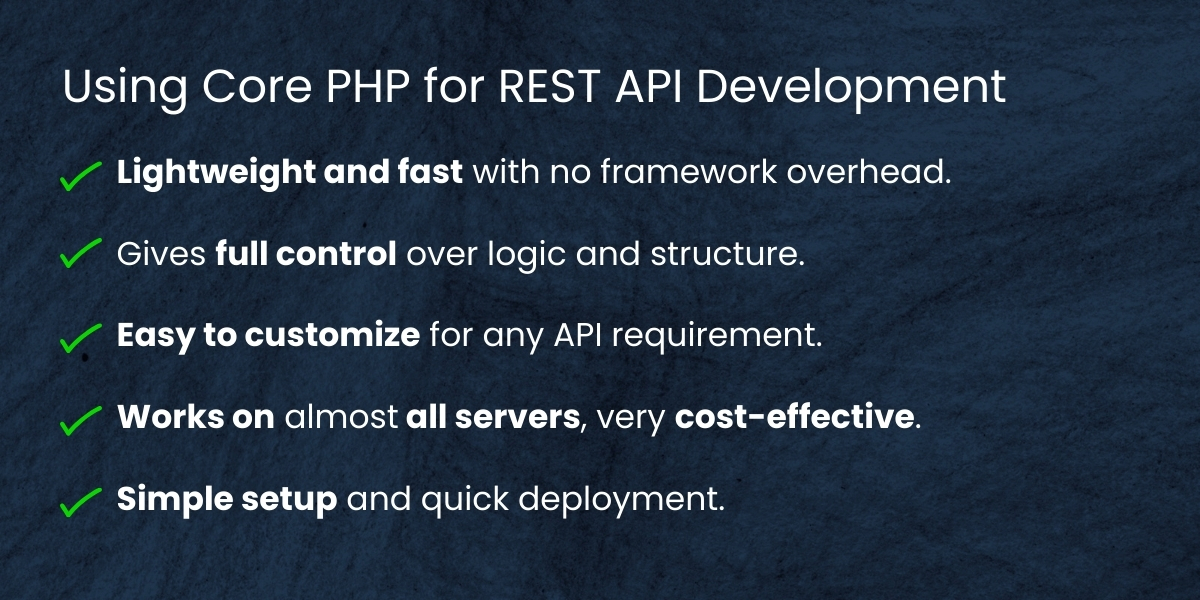RESTful APIs (Representational State Transfer) have come to be the foundation of modern web applications, enabling standardized and scalable communication between clients and servers. This type of API allows different systems, such as mobile apps, web apps, or third-party services, to efficiently exchange data.
While there are many full-featured frameworks like Laravel, Symfony, or CodeIgniter that facilitate API development by providing built-in routing and authentication systems, Core PHP offers a powerful, light-weight alternative code-base for the developer who prefers control and simplicity of a smaller code base. With Core PHP, an efficient, maintainable, and secure RESTful API can be built without the need for larger frameworks.
In this article, we will discuss the structure of REST APIs, its principles, and best practices to build, test, and securely browser or utilize RESTful APIs with only Core PHP.
What is a RESTful API?
A RESTful API is a web service architectural style that uses standard HTTP methods to transfer requests and responses between client and server. Its basic principle is simple: each resource (eg. users, orders or products) should have its unique URL and actions for that resource are performed via HTTP methods:
- GET – Get data from the server
- POST – Send data to the server
- PUT – Update the data
- DELETE – Delete data
REST APIs are stateless, which means that on each request from the client, the request must contain all the information needed (they are said to be self-contained). The returned data is often returned in a JSON format, which makes it easy for front-end or mobile applications to consume the data.
By following REST principles, APIs become scalable, maintainable, and are easy to integrate across platforms.
Why Use Core PHP for REST API Development?
While newer frameworks will help you expedite development, Core PHP is still a valuable option for developers, especially those who want flexibility with minimal dependencies. Here are some reasons to consider using Core PHP.
- Full Control: You can code your application the way you want, request the way you want, and respond the way you want, all without framework restrictions.
- Lightweight Performance: Core PHP APIs don’t load and execute extra libraries or API framework overhead.
- Custom Logic Freedom: Developers can create logic exactly how it is needed and not have extra abstractions, with no abstractions for basic functionality.
- Deeper Understanding: Building APIs from the ground up, you take the brunt of the complexity for routing, HTTP methods, authentication, and update.
For small/medium scale projects, or if you are learning back-end essential principles, Core PHP is a solution.
Fundamentals of a RESTful API in PHP
When creating a useable and functional REST API, there are several components working together:
1. Routing
Routing is the backbone of any RESTful API. It is effectively delegates how to handle incoming requests based on the URL and HTTP method. Every defined route is associated with an action whether it be retrieving users, creating a record, or deleting data. This ensures that each endpoint we define has a clear and distinguished purpose.
2. Database Interaction
Most APIs will retrieve or store information in a database. In Core PHP, we would use either PDO or MySQLi to handle the database interaction efficiently. Structuring our queries properly, using prepared statements, and handling exceptions, are very important so we are able to protect data integrity and user input to mitigate SQL injection.
3. Request Handling
The API will need to be able to recognize and handle the various HTTP methods, GET, POST, PUT, and DELETE. Depending on the request type, we would then manipulate the data layer to perform the appropriate action on the data. Handling requests properly ensures that every function does exactly what the client is expecting.
4. Response Formatting
Every RESTful API must format responses in a defined way, usually JSON. This ensures that we are communicating clearly between the client and server, as well as, providing structure. A well-structured response will contain relevant data, status codes, and messages that will provide clarity.
5. Error Handling
Effective error handling enhances the reliability and usability of APIs. Returning meaningful HTTP status codes—such as 200 (OK), 201 (Created), 400 (Bad Request), 404 (Not Found), and 500 (Internal Server Error)—helps developers quickly identify and resolve issues.
Essential Guidelines for RESTful APIs in PHP
When building a REST API in Core PHP, there are more considerations than simply generating requests and sending back data—it’s about durability and security, and maintenance. Here are just a few key things to think about:
Use Meaningful URLs
Make sure your endpoints are easy to understand, and they follow a logical structure. For example, use /api/users for user data, rather than something verbose like /api/getUsers.php. URLs that are based on resources make it easier to use, and easier to maintain.
Return a Consistent JSON Object
Make sure your API returns a similar object shape for each response. Each return should have clearly defined fields for status, message, and data. It will become clear that it’s designed to make it easily understandable for the users of the API (typically a developer).
Implement Authentication and Authorizations
Security is paramount! You should use API keys, JWT (JSON Web Tokens) or OAuth 2.0 to manage authentication for users and prevent unauthorized access to data. Having an authentication process in place allows for better tracking of API usage and who is making requests.
Take Advantage of Proper HTTP Status Codes
Every API response should include a proper status code. Status codes help developers understand what happened without inspecting the whole message body. This makes debugging easier, and generally the API easier to integrate.
Validate and Sanitize Input
Before interacting with the database, validate all incoming data to prevent SQL injection and cross-site scripting (XSS). Sanitization ensures the integrity of the data and enhances application security.
Handle Cross-Origin Requests (CORS)
If your API will be accessed from multiple domains, enable CORS headers to allow legitimate cross-domain requests. This ensures your API is usable by different front-end applications.
Use Environment Configuration Files
Store sensitive credentials like database names, usernames, passwords, and API keys in a secure configuration file. Avoid hardcoding these values in your PHP scripts. This enhances security and makes deployment easier.
The ACT of Testing your API
Before you launch an API, testing is an extremely important step. You can use tools like Postman, Insomnia or cURL to mimic client requests and verify responses. During testing, you can ensure your endpoints properly:
- Return the correct data type.
- Use proper status codes.
- Handle invalid requests appropriately.
Thorough testing can also point out any potential performance issues or missing validations before the API is deployed.
Benefits of Building REST APIs in Core PHP
- Lightweight and Fast: No framework and no additional overhead.
- Flexible Structure: You can orchestrate the architecture based on your requirements.
- You Control Logical Flow: You can customize any aspect of the API logic easily.
- Better Learning: This is great experience for developers who want to learn about true API and HTTP functionality.
- Easier to integrate: You can easily integrate with a JavaScript front-end like React, Vue.js, or Angular, or a mobile platform, such as Flutter, or React Native.
Conclusion
Creating RESTful APIs using Core PHP allows developers to understand every layer of backend interaction, whether it’s handling a request or sending back data as JSON. While using frameworks allows us to get much done with less development effort, Core PHP provides unique advantages with flexibility, transparency, and control.
Following REST principles, implementing strong security methods, and applying best practices leads to building the best APIs possible—they are performant, scalable, documented, and easy to maintain.
Whether you need to connect a mobile app, integrated with third-party services, or run a dynamic frontend application, Core PHP is a solid foundation for RESTful API development.











